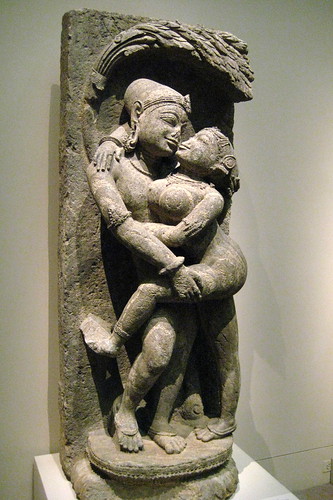Loving Couple (Mithuna)
Eastern Ganga dynasty, 13th century
Orissa, India
Ferruginous stone
A Hindu temple was often envisioned as the world's central axis, in the form of a mountain inhabited by a god. The temple itself was therefore worshiped. This was done by circumambulation (walking around the exterior, in this case in a counterclockwise direction) and by viewing its small inner sanctum. The outside of the temple was usually covered with myriad reliefs: some portrayed aspects of the god within or related deities; others represented the mountain's mythological inhabitants. From early times iconic representations of deities and holy figures were augmented by auspicious images, such as beautiful women, musicians, and loving couples (mithunas). Once part of the subsidiary decoration of a temple facade, the figures of this bejeweled couple embrace while peering rapturously into each other's eyes. Their full bodies and broad, detailed features are characteristic of architectural sculptures produced in thirteenth-century Orissa, a region in northeast India that was noted for its temples, particularly those built from the tenth through the thirteenth century, often distinguished by figures in astonishingly acrobatic and erotic poses. Couples such as this pair are understood to have multiple meanings, ranging from an obvious celebration of life's pleasures to the more metaphorical symbolism of a human soul's longing for union with the divine.
Purchase, Florance Waterbury Bequest, 1970 (1970.44)
Purchase, Florance Waterbury Bequest, 1970 (1970.44)














No hay comentarios:
Publicar un comentario